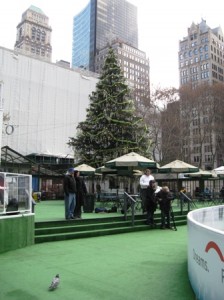 Bryant Park, a 9 plus acre parcel of land, sits in mid-town Manhattan, blending in so well with the hustle and bustle of the city that it practically goes unnoticed, unless one is familiar with it or just happens to stumble onto it. It is located at 42nd and 6th, with the Bank of America skyscraper directly across from it and the New York Public Library on its grounds.
Bryant Park, a 9 plus acre parcel of land, sits in mid-town Manhattan, blending in so well with the hustle and bustle of the city that it practically goes unnoticed, unless one is familiar with it or just happens to stumble onto it. It is located at 42nd and 6th, with the Bank of America skyscraper directly across from it and the New York Public Library on its grounds.
What makes Bryant Park such a jewel is that feels like a Parisian park transported smack in the middle of traffic jammed, gritty NYC. It’s a spot where New Yorkers can relax, read, feed the pigeons, have a chat or buy some food from anyone of the several vendors surrounding it. It is all so civilized, almost from another time: and to my eyes and ears is very reminiscent of The Luxembourg Gardens in Paris.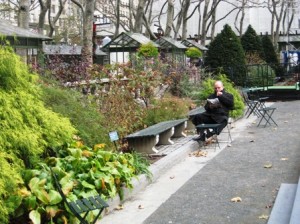 It would be enough if the park was strictly an area filled with boxwoods, ivy and bistro chairs and tables. But this is not the case.
It would be enough if the park was strictly an area filled with boxwoods, ivy and bistro chairs and tables. But this is not the case.
There is a long history associated with this park dating back to 1686 when the area, which was still a wilderness, was designated as a public space by New York’s colonial governor. Over the next sixty some years, the park was used for a variety of causes, one being a graveyard for the poor.
From 1847 on, when it opened as a park under the name of Reservoir Square, this large chunk of land went through several transformations, finally being given the name of Bryant Park in 1884. During The Great Depression, it was redesigned with a large lawn, evergreen hedges and an iron fence, delineating it as a separate park from the streets of NYC.
 By the time I moved to NYC in the early 70s, Bryant Park had become a haven for the homeless, drug dealers and prostitutes. Much like Central Park, it was considered an unsafe place to be after sunset. In 1980, a group of well known New Yorkers funded and created a corporation, called The Bryant Park Restoration Corporation, under the leadership of a fellow by the name of Dan Biederman, with the goal of making Bryant Park into a beautiful respite where New Yorkers could congregate.
By the time I moved to NYC in the early 70s, Bryant Park had become a haven for the homeless, drug dealers and prostitutes. Much like Central Park, it was considered an unsafe place to be after sunset. In 1980, a group of well known New Yorkers funded and created a corporation, called The Bryant Park Restoration Corporation, under the leadership of a fellow by the name of Dan Biederman, with the goal of making Bryant Park into a beautiful respite where New Yorkers could congregate.
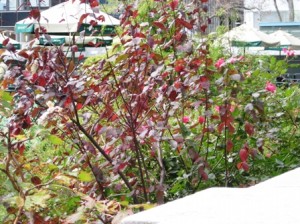 In 1988, the park closed for 4 years for a major renovation which included a lush garden design created by Lynden Miller, a well known public garden designer, who has been instrumental in developing public spaces throughout the boroughs of New York. The garden is both exuberant, yet restrained and simple. Miller is masterful at creating luscious plant combinations and incredibly adept in the use of repeating plant material and creating a garden with 4 seasons of interest.
In 1988, the park closed for 4 years for a major renovation which included a lush garden design created by Lynden Miller, a well known public garden designer, who has been instrumental in developing public spaces throughout the boroughs of New York. The garden is both exuberant, yet restrained and simple. Miller is masterful at creating luscious plant combinations and incredibly adept in the use of repeating plant material and creating a garden with 4 seasons of interest.
Even on a very cold day in mid-November, Salvia guaranitica and Rosa ‘Betty Prior’ were still in bloom.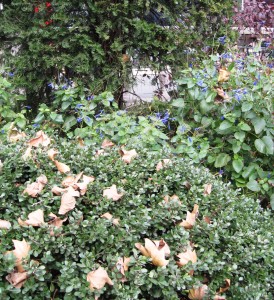 A few of the other specimens that I continually notice as I stroll through the park, regardless of what season it is, are: Hydrangea quercifolia, Hydrangea macrophylla ‘Variegata’, Salvia ‘van Houtii’, Hemerocallis sp, Hosta sp., Buddleia davidii ‘Nanho Blue’ and Taxus baccata
A few of the other specimens that I continually notice as I stroll through the park, regardless of what season it is, are: Hydrangea quercifolia, Hydrangea macrophylla ‘Variegata’, Salvia ‘van Houtii’, Hemerocallis sp, Hosta sp., Buddleia davidii ‘Nanho Blue’ and Taxus baccata
A piece of history that I find fascinating is that when Biederman began the renovation, he had the foresight to bring in William Whyte, a sociologist and an expert on what constitutes successful public space, as a consultant. The first decision they made was that movable chairs were to be used in the park. Whyte believed that movable chairs gave individuals a sense of empowerment, allowing them to sit and view the garden, skyscrapers or movement of the sun from whatever position they desired. The second decision was to lower Bryant Park to street level. Up until that time, it had been elevated above the street, surrounded by tall hedges (which because of the sense of isolation actually helped in increasing the likelihood of crime).
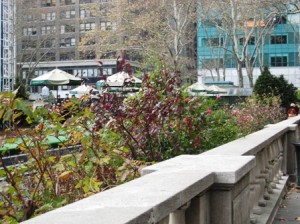 When Bryant Park reopened in 1992, New Yorkers were thrilled and the park was acclaimed by critics. Today Bryant Park is not only a wonderful, open park but has become the grounds where a wide variety of entertainment and educational happenings occur. Here is a listing of some of the events that take place there during the summer: The HBO/Bryant Park Summer Film Festival, The GMA Summer Concert Series, a series of concerts performed by well known classical music organizations in NYC like the New York Philharmonic, New York City Opera, Orchestra of St. Lukes and The New York Pops.
When Bryant Park reopened in 1992, New Yorkers were thrilled and the park was acclaimed by critics. Today Bryant Park is not only a wonderful, open park but has become the grounds where a wide variety of entertainment and educational happenings occur. Here is a listing of some of the events that take place there during the summer: The HBO/Bryant Park Summer Film Festival, The GMA Summer Concert Series, a series of concerts performed by well known classical music organizations in NYC like the New York Philharmonic, New York City Opera, Orchestra of St. Lukes and The New York Pops.
And during the winter months, the center of the park becomes an ice skating rink. It is a sight to behold. With the Bryant Park christmas tree perched on the landing, and the park filled with families, couples and individuals just enjoying themselves and appreciating the nature that surrounds them, one might be tempted to say “It just doesn’t get much better than this”.